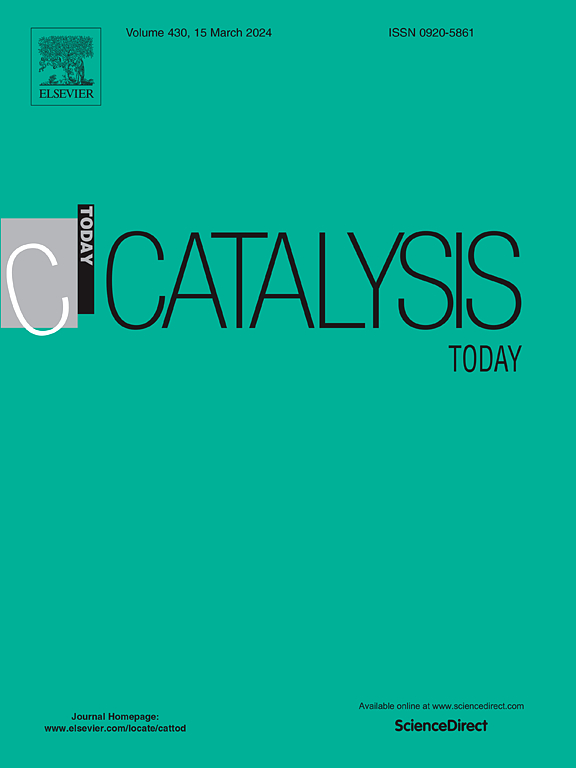Activity of Fe2O3/CeO2-Al2O3 catalysts/oxygen carriers in a fluidized bed chemical looping process for blue hydrogen production
IF 5.3
2区 化学
Q1 CHEMISTRY, APPLIED
引用次数: 0
Abstract
The transition to achieving net zero emissions by 2050 requires a significant increase in green hydrogen, produced using renewable energy and emitting no carbon. As different actors are working on the deployment of technologies to produce green hydrogen at large scale a technological bridge is necessary for the shift from gray hydrogen to green hydrogen in the new energy paradigm. Extensive research is underway to enhance hydrogen production and reduce production costs, particularly in the technology of blue hydrogen production. Chemical looping technology is one innovation developed to reduce the costs by separate CO2 in situ without requiring a separation unit. The success of the chemical looping process depends on selecting the ideal oxygen carrier to facilitate the reaction. Previous research has indicated that iron possesses the desired chemical and physical attributes, making it cost-effective and easily obtainable. Additionally, determining the appropriate amount of iron added to Al2O3 as support is crucial for optimizing the reaction process and preventing the deactivation of the oxygen carrier. This study explores the effects of adding iron to a Ce-modified Al2O3 support in hydrogen production through chemical looping tested in a fluidized bed reactor. Research findings indicate that at a temperature of 650 °C, F20Ce-Al demonstrates more potential for reduction to the iron state in fuel reactors compared to F30Ce-Al, primarily due to the involvement of the water-gas shift reaction (WGSR) in the reaction using F20Ce-Al. During the operation of the steam reactor, it was observed that F30Ce-Al exhibited the highest hydrogen production among the tested oxygen carriers within the first 5–16 seconds. However, beyond 16 seconds, hydrogen production decreased due to agglomeration of the oxygen carrier during the reaction process. In contrast, F20Ce-Al demonstrated the best performance in H2 production compared to the other oxygen carriers.
流化床化学环法制蓝氢中Fe2O3/CeO2-Al2O3催化剂/氧载体的活性
到2050年实现净零排放的过渡需要大量增加绿色氢,使用可再生能源生产,不排放碳。由于不同的参与者正在努力部署大规模生产绿色氢的技术,因此在新能源范式中,从灰色氢向绿色氢的转变需要一座技术桥梁。目前正在进行广泛的研究,以提高氢气产量和降低生产成本,特别是在蓝色氢气生产技术方面。化学环技术是一项创新,通过在不需要分离装置的情况下就地分离二氧化碳来降低成本。化学环化过程的成功与否取决于选择理想的氧载体来促进反应。先前的研究表明,铁具有所需的化学和物理属性,使其具有成本效益和易于获得。此外,确定适量的铁作为载体添加到Al2O3中对于优化反应过程和防止氧载体失活至关重要。本研究通过在流化床反应器中进行化学环测试,探讨了在ce修饰的Al2O3载体中添加铁对制氢的影响。研究结果表明,在650 °C的温度下,F20Ce-Al比F30Ce-Al更有可能在燃料反应堆中还原为铁态,这主要是由于F20Ce-Al在反应中参与了水气转换反应(WGSR)。在蒸汽反应器运行期间,观察到F30Ce-Al在前5-16 秒内表现出最高的产氢率。然而,在16 秒之后,由于氧载体在反应过程中聚集,产氢量下降。与其他氧载体相比,F20Ce-Al表现出最好的产氢性能。
本文章由计算机程序翻译,如有差异,请以英文原文为准。
求助全文
约1分钟内获得全文
求助全文
来源期刊

Catalysis Today
化学-工程:化工
CiteScore
11.50
自引率
3.80%
发文量
573
审稿时长
2.9 months
期刊介绍:
Catalysis Today focuses on the rapid publication of original invited papers devoted to currently important topics in catalysis and related subjects. The journal only publishes special issues (Proposing a Catalysis Today Special Issue), each of which is supervised by Guest Editors who recruit individual papers and oversee the peer review process. Catalysis Today offers researchers in the field of catalysis in-depth overviews of topical issues.
Both fundamental and applied aspects of catalysis are covered. Subjects such as catalysis of immobilized organometallic and biocatalytic systems are welcome. Subjects related to catalysis such as experimental techniques, adsorption, process technology, synthesis, in situ characterization, computational, theoretical modeling, imaging and others are included if there is a clear relationship to catalysis.
 求助内容:
求助内容: 应助结果提醒方式:
应助结果提醒方式:


